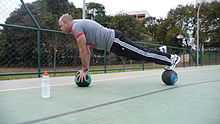Medicine ball


A medicine ball (also known as an exercise ball, a med ball, or a fitness ball) is a weighted ball roughly the diameter of the shoulders (approx. 13.7 inches), and is often used for rehabilitation and strength training. The medicine ball also serves an important role in the field of sports medicine. However, it should not be confused with the larger, inflated exercise ball.
Medicine balls are usually sold as 2–25 lb (0.91–11.34 kg) balls and are used effectively in plyometric weight training to increase explosive power in athletes in all sports. Some medicine balls are in the form of weighted basketballs.
Construction

Medicine balls are generally constructed of a leather or vinyl covered nylon cloth, and filled with impact absorbing materials to give them weight. Vinyl covered medicine balls typically are sand filled and are not used for exercises requiring bouncing. Sand or steel shot filled neoprene bags are also used for medicine ball exercises not requiring bouncing.[1]
Some medicine balls have an inner half sphere of dense material in varying thicknesses and seamed together with an outer rubber shell. Other medicine balls have a thin rubber bladder covered by a thick rubber outer surface. Medicine balls that are constructed with an inner rubber bladder and rubber outer surface incorporate an air valve to pump up the ball and increase the bounce. The outer rubber surface has indented designs for easy handling. Over time the rubber surface may wear down if the medicine ball has been used on rough surfaces.
Other types of medicine ball include balls made of gel-filled polyvinyl chloride shells, and balls made of solid polyurethane.. The materials can vary depending on the desired weight and density.
A basketball can be filled with sand, stitched shut, and used as an effective low-price medicine ball where resources are scarce, and is popular in, for example, home "garage" gymnasia.
Variations
Some producers of medicine balls incorporate handles on or into the ball. One or two handles may be molded into the ball, thereby changing the shape from a sphere. Handles may serve also as a strap for hand security and attach/unattach to the surface of the ball. A handle may also be an attachable rod that is screwed into the ball.
The handle allows the user to grasp the ball either with one or two hands and swing the ball in movements with the weight placed further from the body. Handles that are incorporated into the ball allow the user a closed grip compared to an open grip of a large diameter ball. The user may also put the handle around their foot and complete exercises with added weight to the lower body.
A second variation is an attached rope through middle of the ball. The ball may be hollow with the rope secured at each end of the ball or the ball may be solid with the rope molded into the construction of the ball. These are known as powerballs, slamballs or tornado balls. The user grasps the rope along any length and swings and rotates the ball overheard or around the body. The ball can also be chopped or slammed against the ground or a wall.
A user can convert a traditional medicine ball into a powerball by placing it inside a mesh bag cinched closed by a large rope used as a handle. The rope length should allow the user to wrap the rope around the hand for security.
The greater the distance the weight is from the body the greater the core strength and power required to complete the exercises.
See also
References